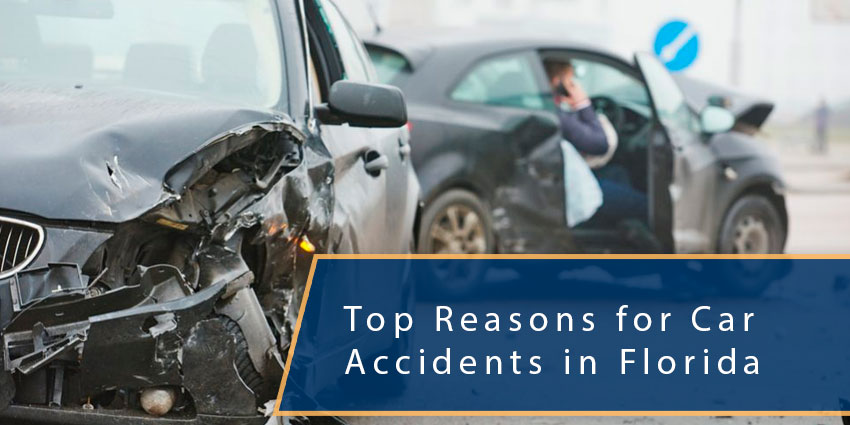There are many reasons for car accidents, but most of them result from driver negligence. Florida sees thousands of car accidents annually. With tourists visiting all year long, traffic often becomes congested. As a result, the risk of accidents increases. This article will explore the leading causes of traffic accidents in Florida.
Table of Contents
Additional Traffic Due to Tourists
Every year, over seven million visitors come to Florida from all over the world. More tourists mean more people using the road. Many tourist and visitor driving behaviors make it hard for other drivers to predict their next move.
That’s because visitors are usually unfamiliar with the roadways and infrastructures in Florida, creating a higher likelihood of accidents. For example, they might need help to make lane changes on time or be unprepared to make sharp turns on the road.
Additionally, tourist traffic means more people might make abrupt stops or slow down unexpectedly to see attractions along the road. One reason is that they often need a GPS or navigation system to get around. As a result, they might need to take their hand off the wheel to adjust the GPS if they take a wrong turn.
Busy Intersections
There are tons of dangerous intersections in Florida. Intersections are dangerous for several reasons. For starters, traffic flows very quickly and goes in multiple different directions. If two cars speed up to beat a yellow light, they could get into a head-on collision. Additionally, some drivers experience poor visibility while moving through intersections.
Some of the most dangerous intersections in Pinellas County include:
- US-19 and 38th Avenue N
- US-19 and 22nd Avenue N
- US-19 and US-19 ALT/5th Avenue N
- Central Avenue and 3rd Street N
- US-92 and 38th Avenue N
- SR-693/66th Street N and 22nd Avenue N
Some drivers avoid these intersections to reduce their overall risk of accidents, but that’s not always possible. No matter how safe or dangerous the roads are, it’s virtually impossible to avoid the risk of an accident altogether. Therefore, drivers need to be more cautious at these intersections to help prevent traffic collisions.
Distractions While Driving
Distracted driving is anything that takes your attention away from driving. Distractions on the road generally fall into one of three categories or a combination of the three: cognitive, visual, or manual. Statistically, distracted driving is just as dangerous, if not more, than drunk driving. Examples of distracted driving include:
- Cell phone use while driving
- Eating
- Texting while driving
- Changing the song on the radio
- Applying makeup
- Reaching for something in the back seat
- Reading a book or newspaper while driving
Cell phone use is the most prevalent and dangerous distraction while driving. Not only does it manually distract the driver, but it also mentally and visually distracts them. It only takes one split second of distraction to cause an accident.
Additionally, texting while driving in Florida is illegal. Florida’s Texting and Driving Law makes it illegal for drivers to text while driving. Drivers who text and drive can face fines and traffic violation citations. However, that’s not even the worst part, as they can cause an accident that risks their safety and the well-being of other drivers on the road.
Visual Distractions
Visual distractions are any distraction that takes the driver’s eyes off the road. Anything from looking at the passenger to looking down at your phone is considered a visual distraction.
Manual Distractions
Manual distractions are anything that takes the driver’s hands off the wheel. Eating, changing the song, texting, or reaching out to change the A/C settings are all examples of manual distractions.
Cognitive Distractions
Any distractions that take the driver’s focus away from the road. Conversations with another person in the car, talking on the phone, or texting are examples of cognitive distractions. Again, texting is one of the most dangerous forms of distraction to drivers because it distracts the driver visually, manually, and cognitively.
Drunk Drivers
Florida drunk driving deaths are declining each year. However, drunk driving is still a pervasive issue. It’s especially common with spring breakers, vacationers, and party goers who come to Florida’s party scene. Vacationers are much more likely to drive while intoxicated because of the nature of their visit.
Sadly, hundreds of lives are lost to drunk driving accidents in Florida yearly. Even if a fatality does not come about from a drunk driving accident, crash victims are likely to sustain severe injuries.
Alcohol is dangerous for drivers because it causes physical impairment, delayed reaction time, and poor judgment. Fast reflexes, decision-making, and the ability to safely control a vehicle are all vital skills for safe driving. Additionally, alcohol can cause drivers to experience tunnel vision or blurry vision, which is a massive risk while operating a vehicle.
Failure to Obey Traffic Laws
Traffic laws and signals exist for a reason: to provide structure and safety on the roads. When drivers violate or ignore traffic laws, that’s when accidents happen. A driver who speeds through a yellow light and accidentally runs a red light can cause a deadly collision.
Nighttime Driving
Florida’s nightlife can get dangerous when people get behind the wheel after drinking.
Drivers on the roadways at night should stay vigilant and be cautious of drunk drivers. Even without drunk drivers, nighttime driving often poses more obstacles for the average driver. For starters, there is less visibility at night. Additionally, applying accurate depth perception at night might be more challenging. That could be deadly for drivers who wish to turn at a busy intersection or around.
Another risk for nighttime driving is drowsy driving. Drivers behind the wheel at night are more likely to be tired from a long day and potentially fall asleep behind the wheel or veer off the road. This is especially true for large or commercial truck operators who drive long distances for extended periods.
Drowsy and tired driving are similar to drunk driving. Drivers may experience visual impairment, poor navigation, and a lack of sharp decision-making skills. If a driver falls asleep behind the wheel, they can lose control of the vehicle, and their foot could accidentally hit the gas while they lose consciousness. This risks the car crashing into an object or creating a pile-up accident.
Poor Weather Conditions
Inclement weather conditions significantly increase the risk of motor vehicle collisions. While Florida experiences beautiful sunny weather for most of the year, it does get its fair share of rainfall. In fact, Florida gets over 60 inches of rain annually. That includes occasional torrential downpours and slippery roads as a result. Rain comes heavily during hurricane season, along with other challenges on the road, including:
- Heavy winds
- Debris and other obstacles in the road, like fallen trees and branches
While visitors and tourists can refrain from driving during heavy rainfall or other dangerous weather conditions, residents who need to work don’t have a choice.
Reckless and Other Dangerous Driving Behaviors
Reckless and aggressive driving can pose a considerable danger to everyone on the roadways. Examples of reckless driving include:
- Excessive speeding
- Aggressive lane changing
- Tailgating
- Failing to use signals when lane changing
- Ignoring traffic signals
Speeding
Speed limits exist to help maintain safe road conditions for drivers. Drivers who speed bring danger to the roadways. Whether to get to work on time or the excitement of being on vacation here, speeding is not beneficial to anyone.
Speed limits in Florida are always clearly posted, and there are consequences for violating speed limits. With increased speeds, accident outcomes are more severe. Drivers need ample time to react safely to obstacles and other drivers.
Lastly, vehicle occupants are more likely to experience severe injuries or fatalities when a crash happens at high speeds.
Vehicle Defects
A less common cause of car accidents in Florida is vehicle defects. Vehicles require consistent and proper maintenance to function optimally and run smoothly. Failure to maintain cars can result in defects that increase the risk of accidents.
For example, faulty windshield wipers could make it near impossible for a driver to see during heavy rain and cause a collision. Or a blown tire could cause a car to run off the road or lose control and cause a multi-car collision. Finally, a poorly maintained engine or transmission can disable a car and cause it to stop in the middle of traffic. This would be deadly while driving at high speeds on the highway or interstate.
To prevent accidents from mechanical issues, car owners should schedule routine car maintenance.
Contact a Florida Car Accident Lawyer Today
Car accidents happen in the blink of an eye. Whether you are a visitor, tourist, or Florida resident, you can seek compensation for damages in an accident caused by another driver.
Call us today for your free initial case review.














